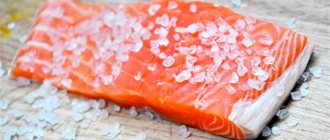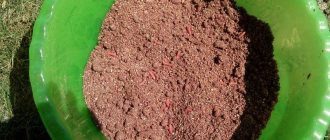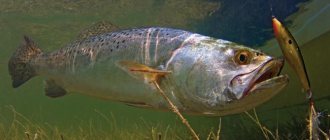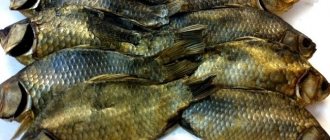Of the many delicacies, salted fish is one of our favorites. Even ordinary boiled potatoes in “company” with lightly salted trout or herring can turn into a festive dish. Salted fish is always tasty and impressive. But the one bought in the store will not stand comparison with the one you salted with your own hands.
If you are convinced that it is unlikely that you will be able to salt seafood at home, your fears are in vain. There is nothing impossible in this process; the main thing is to have high-quality raw materials and adhere to technology.
And it’s impossible to count how many options for salting there are, so tasty and unusual, for different types of fish. Try pickling it yourself. You can start with quick and simple recipes. Once you gain experience, choose your favorite one.
What fish is suitable for salting?
Almost any fish that is found in reservoirs, sold frozen or fresh in markets and stores, can be salted:
| Kinds | Examples of varieties |
| Marine | Flounder, mullet, mackerel, capelin, halibut, herring, herring, mackerel |
| Predatory | Bersch, asp (carp fish), perch, pike perch, catfish, pike |
| Carp | Roach, crucian carp, carp, bream, roach, fisherman, carp, ram, bleak, sabrefish, ide |
| Salmonidae | Loaches, pink salmon, coho salmon, lenok, nelma, salmon, whitefish, taimen, grayling, trout |
Important! Fish weighing up to 0.5 kg do not need to be gutted for salting; fish that are larger have their entrails removed.
Features of salting.
Salting is considered one of the most reliable methods of canning, allowing you to store the product for quite a long time.
For those who have never had to salt fish at home and don’t know how it’s done, it is important to remember that only rock salt and extremely coarse salt are suitable. Do not use iodized products under any circumstances. The pickling will spoil very quickly.
Salting fish at home
Fish is salted at home in different ways. Wet salting is used to ensure uniform penetration of salt into the carcass of uncleaned fish.
Usually small river fish of the carp family are salted in their own juice: white-eye (sop), blue bream, roach, white bream, silver bream, perch, rudd.
Common sea fish are also suitable for wet salting: mackerel, herring, horse mackerel, sprat, anchovy.
Wet home salting is especially often used for long-term storage of herring of all breeds.
Methods for salting fish
There are countless recipes for salting. But there are much fewer ways, and the most common of them are: dry and wet. In the first case, no water, only loose ingredients that are mixed together and rubbed into the fish. But in the second, it is placed in brine - a curing mixture diluted with water.
- Dry salting
The fastest and easiest. Particularly suitable for medium-sized fish - from 250 to 500 g in weight. Both trout and ide, which are larger, are tasty. Fish carcasses laid out in rows are sprinkled with salt. The juice that comes out of the fish after being under pressure will be enough. If after 4 days not enough liquid has formed and the fish carcasses are not completely covered with it, you will have to dilute salt in water (250 g/l) and pour it into the salting.
This method requires direct contact of salt with raw materials. If you provide an air temperature of 15℃, then this process will be especially successful. After ten days, the fish acquires a fairly dense structure, while maintaining its best properties and taste characteristics. However, for fattier (not counting small) fish, dry salting of fish at home is undesirable.
- Salting in brine
This method will require preparing a special brine for salting fish. It is poured over fillet pieces. After being warm for a couple of hours, and then a couple of days in the refrigerator, the delicacy is ready. All that remains is to remove it from the brine, dry it and wrap it in cling film if not serving it right away. Sometimes a cotton piece of fabric is used for these purposes.
How to salt herring
Salted herring is the best snack. Every Russian knows this. That’s why Atlantic or Pacific herring is one of the most common herrings for pickling at home.
One of the most important rules: do not buy fresh fish without heads and fins. Too often spoilage is hidden behind herring cleaned in this way. You can cut it yourself without any problems, but you won’t have to doubt the freshness of the product.
And if you bought ice cream, just leave it in the refrigerator until it thaws. Defrosting in warm water or the microwave is not recommended.
Herring can be salted using both wet and dry methods.
- Recipe No. 1. Classic in brine with spices. The ideal way is to salt the fish whole.
For 2 fish take: liter of water, 2 tbsp. spoons of salt, 1 tbsp. a spoonful of sugar, 3-4 bay leaves, cloves and black and allspice peas to taste.
It is not at all necessary to gut and clean the herring, but it is advisable to remove the gills. Rinse and dry the carcass.
To prepare brine for salting fish, add salt, sugar and spices to boiling water and keep on fire for another 3-4 minutes. And then let it cool.
A plastic container or an enamel pan with a lid is suitable as a container for pickling. You need to put the fish in it and fill it with brine. It should be completely covered. If this is not the case, you can use pressure so that you do not have to periodically turn the herring over.
After 3 hours at room temperature, you can put the container in the refrigerator. Take the sample after two days.
- Recipe No. 2. Dry method.
To pickle one whole herring, you will need a tbsp. a spoonful of salt, a teaspoon of sugar and half a teaspoon of ground black pepper.
Cut off the head and remove the entrails or leave it as is - at the discretion of the hostess. Rinse the herring. And mix the seasonings together. Rub the fish with this mixture. Then wrap it in cling film and seal it in a plastic bag. After two days in the refrigerator, the snack is ready to eat.
Mackerel pickling recipes
Mackerel is another type of fish that is most often chosen for home salting. A quick, spicy brine works best for it. Moreover, the number of spices is almost unlimited. This fish has such a bright, extraordinary taste that it is quite difficult to drown it out even with an abundance of spices.
And the duration of salting regulates the “salinity” of the finished product. For lightly salted, a couple of hours is enough. A saltier version will require a little more time (4 hours). The whole secret is that the fillet is poured with a 36-degree marinade, not hot, so that the mackerel is salted and not cooked.
For one fish you can take:
- 1 small lemon;
- 1.5 tbsp. l. salt;
- 2 bay leaves;
- 15 black peppercorns;
- half a teaspoon each of ground nutmeg, coriander, mustard seeds;
- 2 small onions;
- half a liter of water.
The mackerel must be gutted and the head and tail removed. Wash and cut into pieces one cm thick.
For the marinade, the first onion is cut into rings and, along with salt and other spices, added to hot, but not boiling, water. As soon as it boils, you need to cook over low heat for 7 minutes and leave to cool.
Now cut the lemon into half rings and the second onion into rings. Place them in a deep bowl and pour warm marinade into it. As soon as the fish is there, cover the container with a lid and put it in the refrigerator for two hours. The fish turns out lightly salted with a spicy aroma. If you need it saltier, you'll have to wait a couple more hours.
Spicy marinated mackerel
You will need : 3-4 mackerel, 3 onions, 3 tbsp. oils, 3-4 bay leaves, black peppercorns; for marinade – 1 liter of water, 160 ml of 9% vinegar, 2.5 tbsp. salt.
Cooking . Peel the onions and cut into rings of medium thickness.
Clean the fish, remove the heads, rinse well and dry with paper towels.
Cut the carcasses into large pieces and place them in a bowl where the fish will be marinated (if the mackerel is small, it can be marinated in carcasses).
Place onion rings on the prepared fish, add peppercorns and bay leaves.
For the marinade, mix water, salt, and 9% vinegar in a separate container. Stir thoroughly until the salt is completely dissolved.
Pour the marinade over the fish with onions and spices, add 3-4 tbsp. odorless vegetable oil. As a result, the marinade should completely cover the contents of the bowl.
Cover the bowl with a lid or cling film and put it in the refrigerator for a day.
How to salt red fish
Red fish serves as an excellent appetizer and makes unusually tasty salads. The one sold in any supermarket is expensive. It is often very difficult to be sure of its quality. That’s why many chefs, who know exactly how to deliciously pickle fish, prefer to prepare this delicacy at home. And the recipes are especially in demand among the myriad of ways to prepare seafood.
Important! Usually, when talking about “Red Fish”, they mean individuals of delicious varieties from the salmon family. Their pulp has a high fat content. That is why, in its lightly salted version, it acquires a delicate and pleasant taste and is present at almost all festive feasts.
Let's talk about how to salt red fish at home.
Dry salting
Fish can be used both fresh and frozen. The main thing is that the skin is free of any damage, yellow spots or streaks. and no off-putting smell.
When cutting, remove the scales from the fish and wash it well under running cold water. The head, tail and fins are not required for salting, but they will make an excellent fish soup.
The abdomen is cut open, carefully removing the entrails. The backbone of the carcass is removed (it can also go into the ear). Caviar can also be salted.
As for the skin, it is usually removed, but you can leave it. In this recipe we cook fish without skin.
The fillet is placed in a pan, sprinkled with salt and saltpeter in a ratio of 400 g to 5 g, respectively. The fish must be kept under pressure for 3 days. After this, mix the pieces and leave for the next 3 days.
Now you can hang them to dry in the sun. Some additionally smoke it, some rub it with liquid smoke.
Salting in brine
Unfortunately, such fish can be stored for no longer than 3-5 days. Sometimes, in order to extend this period for a short time, a day after salting, the brine is drained from the fish, dried, and poured with vegetable oil.
For the brine you will need:
- 0.5 l of water;
- 2 tbsp. spoons of salt;
- 1 tbsp. spoon sugar;
- spices: black peppercorns and bay leaf.
Bring to a boil, the brine is first cooled and then poured into the fish. She remains in a cold place for several days. If you replace the water with strong tea, the product will take on a smoky flavor.
Fish in its own juice
Perhaps this option for salting red fish at home will be more preferable for you. A certain compromise when it is salted in a humid environment. But not in the brine, specially brewed for this occasion, but in its own juice, released during salting. The skin is often left and, if cut, it is into large pieces. For this kind of salting, sugar is often used (in the proportion of 2 parts salt to 1 sugar). But you can do without spices.
The fish is coated with the curing mixture on all sides. The pieces can be folded in pairs so that their loin parts are adjacent to each other. Wrapped tightly in a clean piece of cotton, they are placed in a container. Under pressure, in about an hour the juice that is needed for pickling will appear.
Gravlax
This method was once invented by Scandinavian fishermen. They needed to somehow prevent the fresh catch of salmon, salmon, etc. from going to waste. Gravlax was prepared right in... the sand a little above the surf line. But this is extreme. Today, such a spicy and aromatic delicacy is prepared in the kitchen.
Interesting! Typically, fish is salted using this method for several days. But we will talk about a quick version of this recipe with salmon from the famous English chef Jamie Oliver.
Take a risk! Take a 300 g piece of salmon with skin and:
- 1 tbsp. spoon of brown sugar;
- 3 tbsp. spoons of sea salt;
- half an orange;
- zest of 1 lemon;
- a large bunch of dill;
- 25 ml vodka.
Separately prepare the dill stalks. In one bowl, mix lemon and orange zest, salt, sugar and alcohol. Add finely chopped dill stems to them. Carefully coat the fish with this marinade, place the pieces with the flesh next to each other and wrap tightly with cling film. It should sit in the refrigerator for five hours (longer is possible).
Now you can “unpack” the fish, remove excess salt from it and generously sprinkle with chopped dill leaves. You can serve immediately, freed from the skin, or you can put it back in film and refrigerate.
When the fish is served, the skin is removed.
Gravlax
This Scandinavian method of salting fish was once invented by fishermen who needed to preserve their fresh catch. Initially, gravlax was prepared right in... the sand just above the surf line. However, we still won’t do such extreme things and will cook this delicate fish in the kitchen.
Gravlax is prepared from red fish - salmon, salmon, trout, chum salmon. Due to the fact that fresh dill is used for pickling, it turns out very spicy and aromatic. Gravlax can take several days to brine, but there is also a quick version of this recipe with salmon, developed by the famous Jamie Oliver. It is no less tasty, and it is very easy to prepare.
Smaller fish need not be gutted or cut up.
Popular recipes for salting fish
Salting fish at home is not a difficult task and can be done by a cook of any qualification. It will not be difficult for a novice housewife. Most recipes for salting fish at home are quite primitive and require the addition of only salt and water.
Among the most commonly used:
- sugar,
- peppercorns,
- carnation.
There are other components as well. This is vegetable oil, honey, ground pepper, curry, garlic, onion, herbs. Many recipes call for cutting the fish into pieces. But small fish can be salted whole.
According to your choice and taste, you can make it lightly salted or salty.
Classic pickling
For this method, you can select both small and large individuals. To salt 2 kg, use 6 tbsp. spoons of salt and 1 tbsp. spoon of sugar.
It is better to cut the dressed fish into equal parts. Each piece of fillet is coated in a mixture of salt and sugar. Place the slices in a glass jar and leave for 10 hours in a cool place.
Important! If you don't like the presence of sugar, you can do without it. But it is sugar that makes fish fillets softer.
Pickling in vodka
Take half a kilo of small or medium fish, as well as:
- 1 tbsp. a spoonful of salt;
- ½ teaspoon sugar;
- 10 g pepper;
- half a glass of vodka.
Fish fillets, sprinkled with spices and poured with vodka, should be kept under pressure for a day. After this, it is placed in a dark, cool place for 60 hours.
Pickling with honey
An old and very simple recipe. And the brine for salting fish is prepared only from salt, honey and water. And what’s especially important is that the product is ready super quickly. Just a couple of hours and you can enjoy a delicious snack. Most often, red fish is prepared this way, but any low-fat varieties are perfect.
You need to prepare 1 kg of fish and take:
- Half a liter of water;
- 4 tbsp. spoons of salt;
- 2 tbsp. spoons of honey;
- 3 tbsp. spoons of sunflower oil.
First, cut the fish into slices no thicker than 4 cm and place in a deep dish. It will remain in the brine for 45 minutes, after which the excess can be removed with a paper napkin. The fish is greased with oil and sent into the cold for an hour. If you need it lightly salted, you can eat it; if you want it saltier, let it sit for another hour.
Salting fish with ginger
Take a kilogram of fish and:
- water 1 l.;
- salt 200 gr.;
- sugar 1 tbsp. l.;
- bay leaf 4 pcs.;
- pepper 8 peas;
- cardamom and ginger.
The prepared carcass is sprinkled with salt and left in the cold. After a day, all the juice that she gave must be drained and filled with chilled brine. After 4 days, it is drained and replaced with a newly brewed one. After another 5 days they do the same. After two days, the fish is ready. If it turns out to be too salty, just keep it in cold water for a while.
Pickling in lemon juice
For 1 kg of fish you need:
- 4 tbsp. spoons of salt;
- 4 bay leaves;
- half a lemon;
- ground pepper.
The fish, cut into slices, is sprinkled with salt and pepper and sprinkled with lemon juice. Bay leaf is placed between the pieces (it can be chopped). The remaining lemon pulp is usually sliced and placed on top of the fish fillet. The product should stand in the refrigerator for two days. Before eating, wash off any remaining salt from the pieces of fish.
Salting in soy sauce
You will need half a kilo of fish, as well as:
- 3 tbsp. l. soy sauce;
- 1 tbsp. spoon of salt;
- ½ tbsp. spoons of sugar;
- 2 tbsp. spoons of lemon juice;
- 2 tbsp. spoons of vegetable oil;
The fillet is rubbed with a mixture of salt and sugar. Prepare a brine from the remaining juice, oil and sauce, pour it over the fish. After standing in the refrigerator for 3 days, you get a lightly salted delicacy.
In apple juice
Do you want to get herring (this fish is preferable to others for this salting method) with an unusual fruity flavor? This almost lightning-fast recipe for salting herring is a real find.
For 600 g of fish you need to take:
- 3 tbsp. spoons of salt;
- 2 tbsp. spoons of sugar;
- half a glass of apple juice;
- 10 g allspice (corns)
- 40 ml vegetable oil.
The finished fish fillet is cut into portioned slices. Apple juice, heated to 36℃, is mixed with vegetable oil, salt, sugar and seasonings. Herring, folded in a glass jar, is filled with brine. Once it has cooled completely, you can put it in the refrigerator for 2 hours. And everything is ready.
How to salt fish for drying
Every experienced fisherman knows how to salt fish for drying. And he understands that a big catch on a hot day can create problems if you don’t know that it’s much easier to keep caught fish dried than fresh. The main thing is to choose the right drying method.
First, about the rules:
- The best weather for drying and drying in camp conditions is windy.
- The optimal temperature is up to 20℃.
- A solution of manganese (used to wipe the fish) and ordinary gauze will help protect against insects.
- The process lasts up to two weeks.
- Fabric bags are used to store dried fish.
This method is most suitable for large fish. It is necessary to carefully cut the fish: remove the insides, divide it into two halves, and dry it. The inside is sprinkled with salt and then placed in layers in a wooden box. It is convenient because the juice can easily flow out through the holes.
The box must be placed in a hole dug in the shade and covered with film. Insects should not “break through” to the fish. After all, the box will remain in the ground for a week.
The salted fish is washed in cold water and soaked for some time . The poles act as a dryer. Salted fish are hung on them at high altitudes to dry for 7-10 days. Gauze is placed on top.
Salting for smoking
Today, no one is surprised when the owner offers to try home-made smoked fish as a treat. Moreover, there are many smoking recipes. And the most important stage in the process of obtaining this desired product is salting the fish. An experienced smoker makes this according to his own recipe and knows many secrets so that the end result is a real delicacy.
Strictly speaking, you can salt fish for smoking in one of the well-known ways:
- Rubbing the product with salt;
- Soaking in salt solution (recommended for beginner smokers). For brine, take kg of salt per 5 liters of water. Fish that is poured with brine must be completely covered with it. You can use oppression.
The ambassador lasts 1.5 - 2 days. The fish does not require washing. It is simply dried for several hours, then sent to the smokehouse.
Salting of fish is carried out in two stages
- The first stage is salting. During salting, salt particles penetrate into the tissues of the fish.
- At the second stage, called maturation, complex chemical changes occur in tissues and their constituent proteins and fats. During the ripening process, fish acquires new taste properties. Salting takes several hours, and ripening takes several weeks or months. When ripening, it is important to maintain the correct temperature, which should be from 0 °C to -8 °C.











